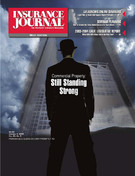The last Oldsmobile, painted a commemorative dark cherry red, rolled off the assembly line in April 2004. During its 107-year history, the company produced more than 35 million cars and pioneered innovations like chrome-plated trim and front-wheel-drive. Oldsmobile sold more than a million cars a year in the 1980s, but sales had plummeted by 2000 when GM announced it would phase out the brand.
Car and Driver called Oldsmobile’s collapse “more a failure of marketing and sales strategies than it is of the automobiles themselves.” So the image of that last car is relevant to us because it points to strong commonalities that determine success or failure in the marketplace. We can learn a lot from it.
Lesson 1:
Understand the needs and expectations of your customers–and have a clear, effective strategy for meeting them.
Consumer needs have changed significantly in the 25 years I’ve worked in the insurance industry. Our commercial customers grapple with a complex business environment: regulatory and compliance issues, productivity challenges and customer service demands are only a few examples. Underestimating the magnitude of these realities and the expectations they create is inviting obsolescence.
Agencies and carriers must listen, understand and adapt if we are to meet–and exceed–those expectations. That makes it critical to develop and implement the right strategy. The inertia of maintaining the status quo because something worked well in the past is not a strategy. Because insurance is still a relationship business, approaches that build solid relationships continue to serve us well. But many transaction processes can bog us down in expensive, time consuming inefficiency, sending customers down the street in search of the customer experience they demand and deserve.
I was recently invited by a leading independent agency in Pennsylvania to speak to their clients and prospective customers about the commercial lines marketplace, Selective’s regional advantages and our products and services. This is a dynamic, proactive and growing agency. Anticipating customers’ needs is embedded in their vision statement, and the result is a sales culture intrinsic to the way they do business every day. They tailor a service plan for their clients, a blueprint for services they provide throughout the year, not just at renewal time. Everything they do is designed to make their agency a professional partner to their clients and with us as one of their insurance carriers.
By building a customer-centric agency they increase customer loyalty, the key to long-term growth and profitability. They have a strategy that works.
Lesson 2:
Know who you are; communicate it clearly.
“Brands that lose their punch get yanked.” That headline topped a USA Today article about GM’s decision to kill off the Oldsmobile brand. Let’s not make the mistake of thinking that “survival of the fittest” applies only to automotive giants and other name brand entities. Once-familiar carriers have disappeared; once-successful agencies have failed.
Successful branding creates an awareness of the services and products that differentiate you from competitors and builds customer loyalty. Branding, like strategy, is critical to customer retention, growth and profitability.
What makes an agency decide to place business with Selective? We constantly communicate with our agent partners about what they and their customers need and want from a carrier of choice. We work diligently to meet those needs. Equally as important, our success at communicating our strengths and advantages creates a distinctive brand that differentiates Selective in the marketplace.
What brings a customer to your agency? Like Oldsmobile, the Pennsylvania agency I described earlier was established in the 1890s. Unlike Oldsmobile, they have a firm grip on who their customers are and what they need. They are developing a sales culture that businessman and author Jack Mitchell calls hugging–making the customer more important than anything else.
In “Hugging Your Customer,” Mitchell defines hugging as “getting everyone on your team to sell with passion so you develop long-term loyal relationships with your customers.” The long-term result, he says, is a unique relationship between the business and the customer, a loyalty built on trust and sales.
Significant opportunities for growth
Our industry provides significant opportunities for profitable growth. The commercial lines market grew 9.8 percent to $220.5 billion in 2003, with independent agents and brokers writing approximately 71 percent of this business (source: A.M. Best). Such abundance makes growth possible, not easy. Growing your customer base demands a clear strategy, proactive sales culture and the ability to clearly communicate the advantages you bring to the table.
Gregory E. Murphy (gregory.murphy@selective.com) ischairman, president and CEO of Branchville, N.J-based Selective Insurance Group Inc. The company,which offers primary and alternative market insurance for commercial and personal risks, has been rated “A+” (Superior) by A.M. Best for 43 consecutive years.
Was this article valuable?
Here are more articles you may enjoy.


 Former Congressman Charged After Collision with State Trooper in Florida
Former Congressman Charged After Collision with State Trooper in Florida  Chubb Wins Latest Battle With New York Diocese in Bid to Avoid Sex Abuse Claims
Chubb Wins Latest Battle With New York Diocese in Bid to Avoid Sex Abuse Claims  GM Ends OnStar Driver Safety Program After Privacy Complaints
GM Ends OnStar Driver Safety Program After Privacy Complaints  California Sees Two More Property Insurers Withdraw From Market
California Sees Two More Property Insurers Withdraw From Market 


